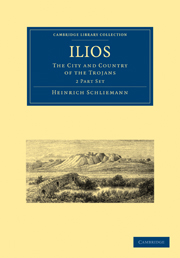Book contents
- Frontmatter
- Contents
- MAPS AND PLANS
- DIAGRAM
- COMPARATIVE TABLE OF FRENCH AND ENGLISH MEASURES, EXACT AND APPROXIMATE
- PREFACE
- INTRODUCTION.—AUTOBIOGRAPHY OF THE AUTHOR, AND NARRATIVE OF HIS WORK AT TROY
- CHAPTER I THE COUNTRY OF THE TROJANS (οἱ Τρῶες)
- CHAPTER II ETHNOGRAPHY OF THE TROJANS: THEIR SEVERAL DOMINIONS IN THE TROAD: TOPOGRAPHY OF TROY
- CHAPTER III THE HISTORY OF TROY
- CHAPTER IV THE TRUE SITE OF HOMER'S ILIUM
- CHAPTER V THE FIRST PRE-HISTORIC CITY ON THE HILL OF HISSARLIK
- CHAPTER VI THE SECOND PRE-HISTORIC CITY ON THE SITE OF TROY
- CHAPTER VII THE THIRD, THE BURNT CITY, Page 305 to 357
- THE THIRD, THE BURNT CITY, Page 358 to 413
- THE THIRD, THE BURNT CITY, Page 414 to 465
- THE THIRD, THE BURNT CITY, Page 466 to 517
- CHAPTER VIII THE FOURTH PRE-HISTORIC CITY ON THE SITE OF TROY
- CHAPTER IX THE FIFTH PRE-HISTORIC CITY OF TROY
- CHAPTER X THE SIXTH CITY, MOST PROBABLY A LYDIAN SETTLEMENT
- CHAPTER XI THE SEVENTH CITY: THE GREEK ILIUM; OR NOVUM ILIUM
- CHAPTER XII THE CONICAL MOUNDS IN THE TROAD CALLED THE HEROIC TUMULI
- APPENDIX I TROY AND HISSARLIK
- APPENDIX II ON THE RELATION OF NOVUM ILIUM TO THE ILIOS OF HOMER
- APPENDIX III THE INSCRIPTIONS FOUND AT HISSARLIK
- APPENDIX IV THYMBRA, HANAÏ TEPEH
- APPENDIX V MEDICAL PRACTICE IN THE TROAD IN 1869
- APPENDIX VI CATALOGUE OF THE PLANTS HITHERTO KNOWN OF THE TROAD, COMPILED ACCORDING TO THE COLLECTIONS OF PROFESSOR RUDOLF VIRCHOW AND DR. JULIUS SCHMIDT, AND FROM THE LITERARY SOURCES BY PROFESSOR PAUL ASCHERSON OF BERLIN, PROFESSOR THEODOR VON HELDREICH OF ATHENS, AND DOCTOR F. KURTZ OF BERLIN
- APPENDIX VII ON THE LOST ART OF HARDENING COPPER
- APPENDIX VIII ON HERA BOÖPIS
- APPENDIX IX TROY AND EGYPT
- INDEX
- Plate section
APPENDIX III - THE INSCRIPTIONS FOUND AT HISSARLIK
Published online by Cambridge University Press: 05 August 2011
- Frontmatter
- Contents
- MAPS AND PLANS
- DIAGRAM
- COMPARATIVE TABLE OF FRENCH AND ENGLISH MEASURES, EXACT AND APPROXIMATE
- PREFACE
- INTRODUCTION.—AUTOBIOGRAPHY OF THE AUTHOR, AND NARRATIVE OF HIS WORK AT TROY
- CHAPTER I THE COUNTRY OF THE TROJANS (οἱ Τρῶες)
- CHAPTER II ETHNOGRAPHY OF THE TROJANS: THEIR SEVERAL DOMINIONS IN THE TROAD: TOPOGRAPHY OF TROY
- CHAPTER III THE HISTORY OF TROY
- CHAPTER IV THE TRUE SITE OF HOMER'S ILIUM
- CHAPTER V THE FIRST PRE-HISTORIC CITY ON THE HILL OF HISSARLIK
- CHAPTER VI THE SECOND PRE-HISTORIC CITY ON THE SITE OF TROY
- CHAPTER VII THE THIRD, THE BURNT CITY, Page 305 to 357
- THE THIRD, THE BURNT CITY, Page 358 to 413
- THE THIRD, THE BURNT CITY, Page 414 to 465
- THE THIRD, THE BURNT CITY, Page 466 to 517
- CHAPTER VIII THE FOURTH PRE-HISTORIC CITY ON THE SITE OF TROY
- CHAPTER IX THE FIFTH PRE-HISTORIC CITY OF TROY
- CHAPTER X THE SIXTH CITY, MOST PROBABLY A LYDIAN SETTLEMENT
- CHAPTER XI THE SEVENTH CITY: THE GREEK ILIUM; OR NOVUM ILIUM
- CHAPTER XII THE CONICAL MOUNDS IN THE TROAD CALLED THE HEROIC TUMULI
- APPENDIX I TROY AND HISSARLIK
- APPENDIX II ON THE RELATION OF NOVUM ILIUM TO THE ILIOS OF HOMER
- APPENDIX III THE INSCRIPTIONS FOUND AT HISSARLIK
- APPENDIX IV THYMBRA, HANAÏ TEPEH
- APPENDIX V MEDICAL PRACTICE IN THE TROAD IN 1869
- APPENDIX VI CATALOGUE OF THE PLANTS HITHERTO KNOWN OF THE TROAD, COMPILED ACCORDING TO THE COLLECTIONS OF PROFESSOR RUDOLF VIRCHOW AND DR. JULIUS SCHMIDT, AND FROM THE LITERARY SOURCES BY PROFESSOR PAUL ASCHERSON OF BERLIN, PROFESSOR THEODOR VON HELDREICH OF ATHENS, AND DOCTOR F. KURTZ OF BERLIN
- APPENDIX VII ON THE LOST ART OF HARDENING COPPER
- APPENDIX VIII ON HERA BOÖPIS
- APPENDIX IX TROY AND EGYPT
- INDEX
- Plate section
Summary
Not the least interesting and important of the results obtained from Dr. Schliemann's excavations at Hissarlik is the discovery that writing was known in the north-western corner of Asia Minor long before the introduction of the Phoenician or Greek alphabet. Inscribed objects are not indeed plentiful, but sufficient exist to show that the ancient inhabitants of the place were not wholly illiterate, but possessed a system of writing which they shared with the neighbouring nations of the mainland and the adjacent islands. Throughout Asia Minor a syllabary was once in use, which conservative Cyprus alone retained into historical times.
Numerous inscriptions in this syllabary have been found in the latter island. The characters, which amount to at least fifty-seven in number, long resisted all attempts at decipherment, but at last the problem was successfully solved by the genius of the Assyrian scholar, the late Mr. George Smith, with the help of a mutilated bilingual inscription, written in Phoenician and Cypriote. The language concealed under so strange a garb turned out to be the Greek dialect spoken in Cyprus, a dialect full of interesting peculiarities, and especially noteworthy as preserving up to the fourth century b.c. the two sounds of v and y (or digamma and yod), which had disappeared elsewhere. To the student of Homer the dialect is of considerable importance, since several of the grammatical forms found in the Iliad and Odyssey can be shown to have had a Cyprian origin.
- Type
- Chapter
- Information
- IliosThe City and Country of the Trojans, pp. 691 - 705Publisher: Cambridge University PressPrint publication year: 2010First published in: 1880

